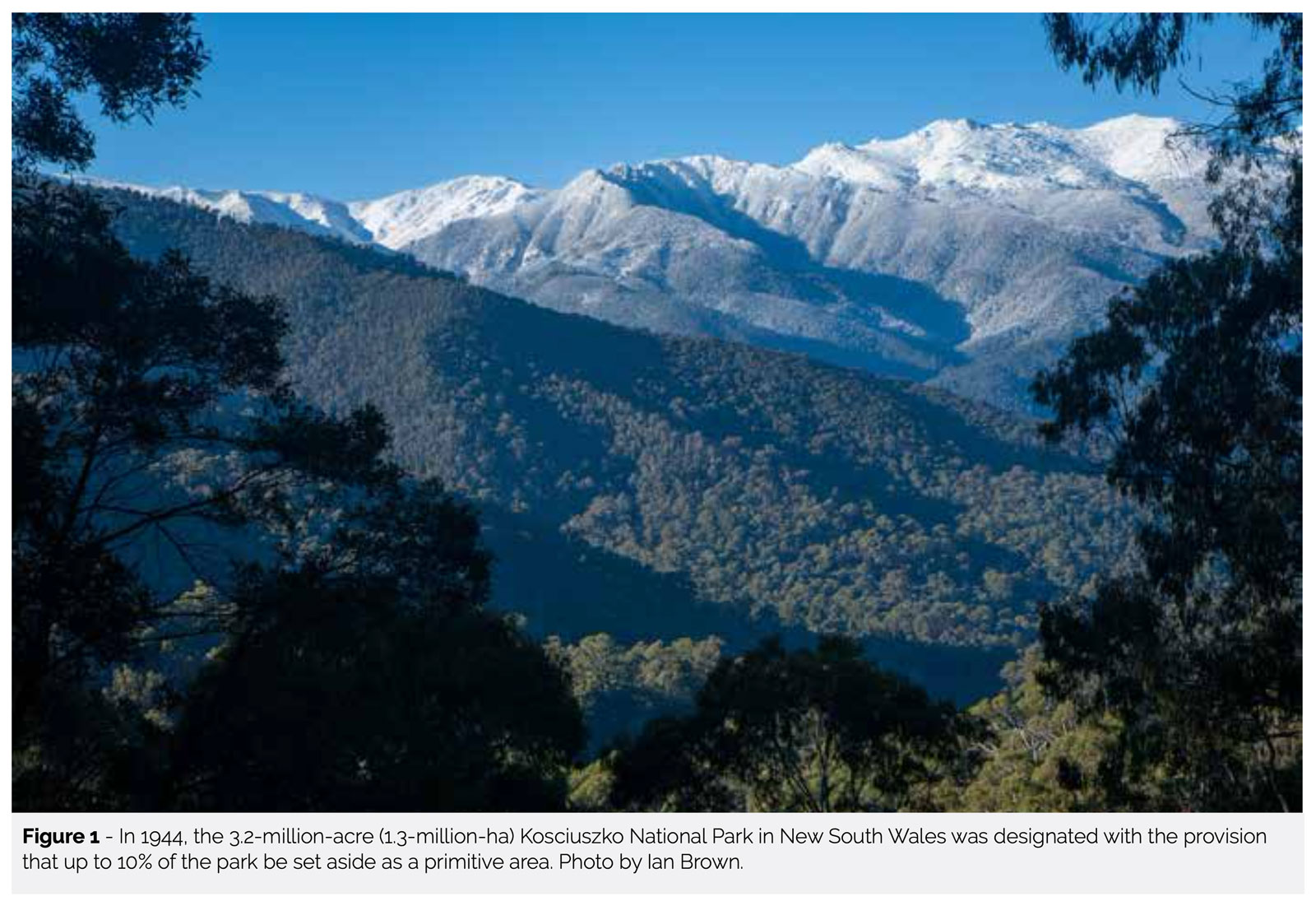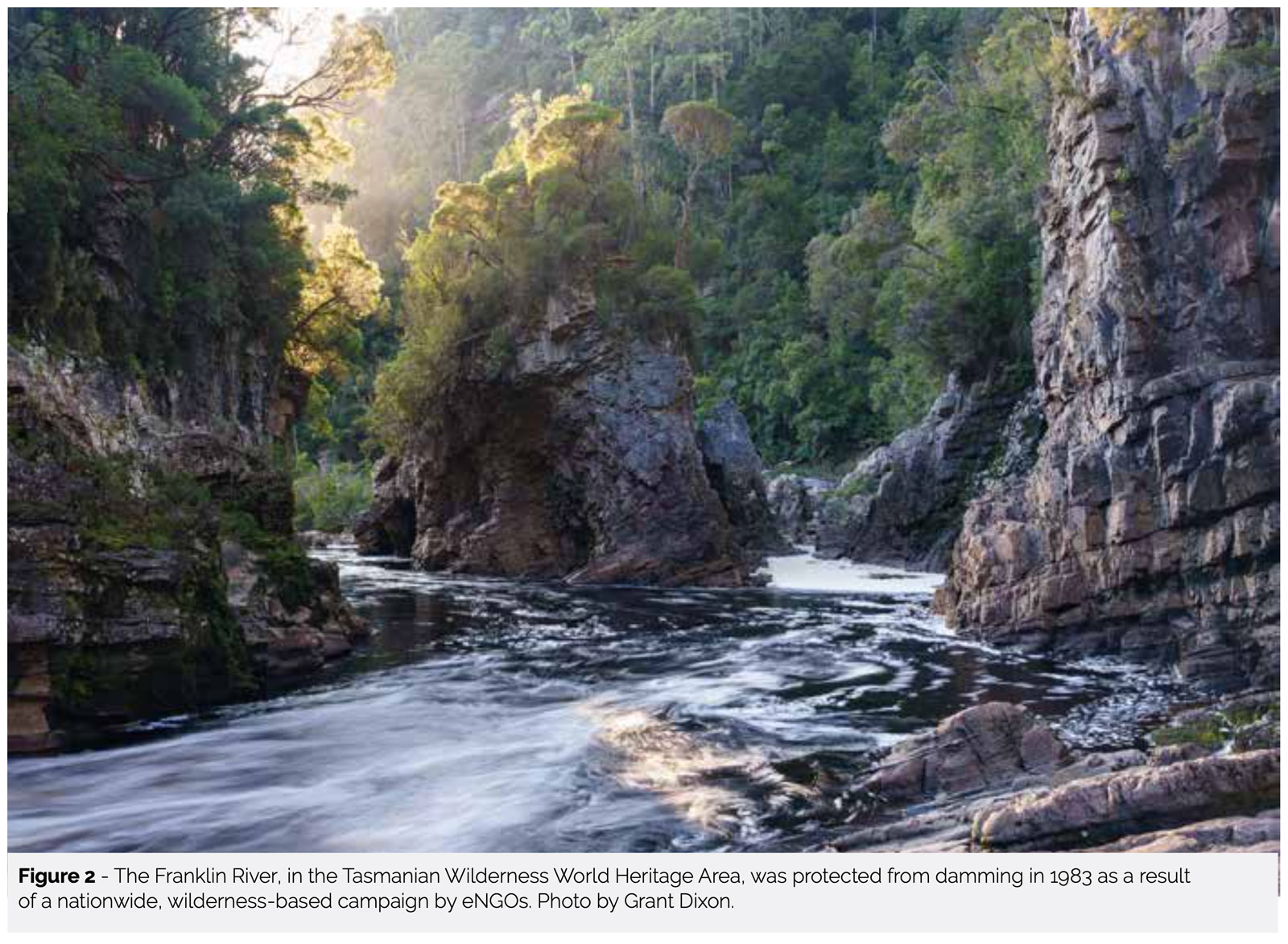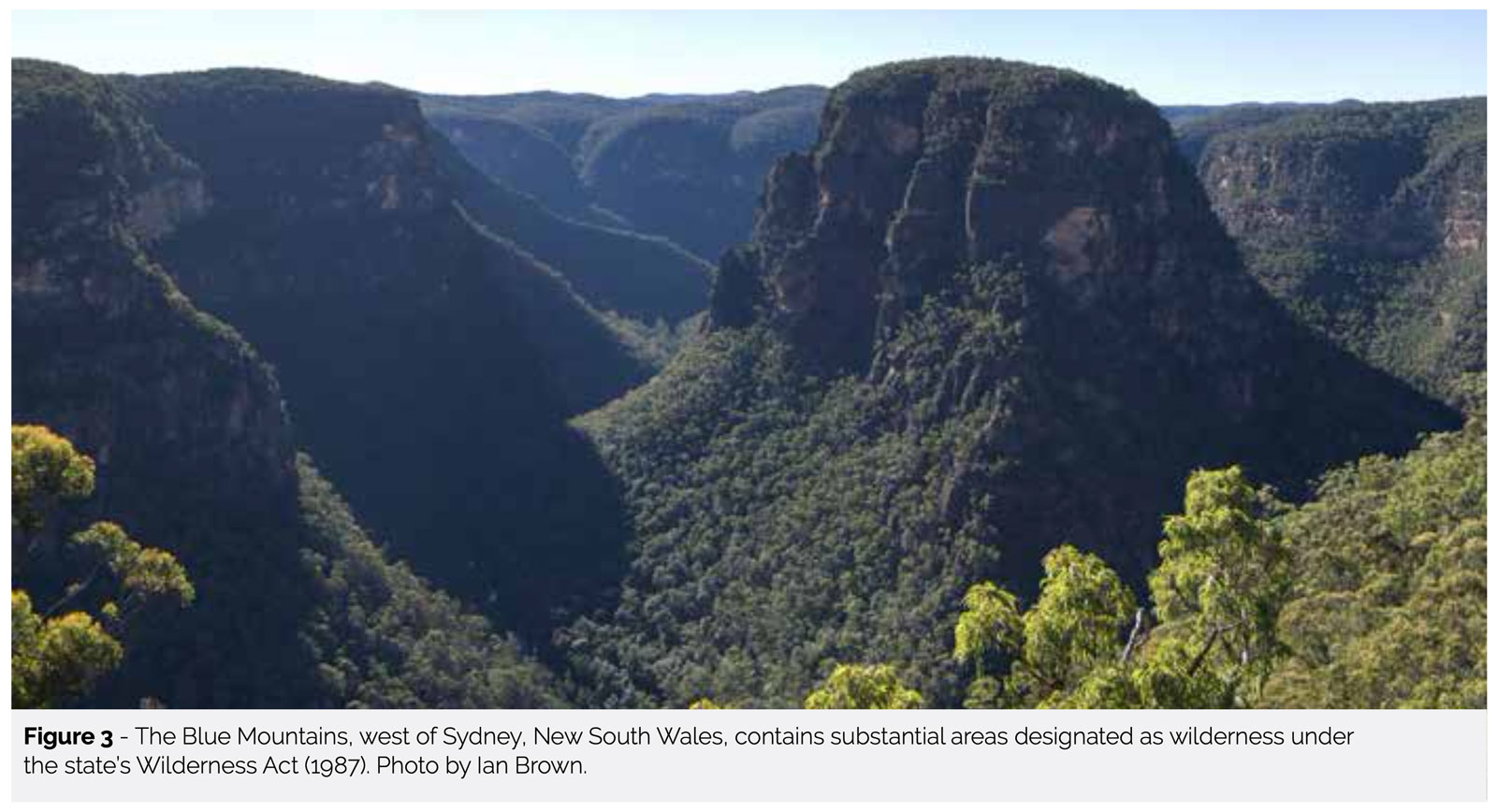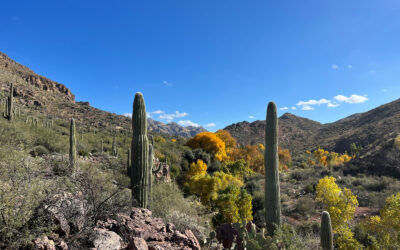In areal terms, much of Australia’s remaining wilderness comprises arid country. Photo credit: Grant Dixon
Wilderness Babel: Perceptions of Wilderness in Australia
by MARTIN HAWES and GRANT DIXON
International Perspectives
April 2024 | Volume 30, Number 1

Wilderness Babel is a project created by Marcus Hall, Wilko Graf Von Hardenberg, Tina Tin, and Robert Dvorak from the original online exhibit at the Environment and Society Portal of the Rachel Carson Center for Environment and Society. It has been developed as an ongoing IJW series that discusses the terminology chosen to express wilderness as a concept in other languages or the nuances of this word in different English-speaking contexts. It discusses the adoption of the term “wilderness” in other cultural contexts – as well as other wilderness terms, from “outback” to “jungle,” and “bush” to “country.” And it explores how concepts of wilderness have found expression in visual representation in media of different sorts as well as in nonverbal communication.
Australia is one of only five countries that collectively contain 70% of the planet’s remaining wilderness outside Antarctica (Watson et al. 2018). Having one of the lowest population densities of any settled country, Australia is also highly urbanized. Hence, a large part of the country remains sparsely populated, although extensive areas show the influence of rangeland agriculture, logging, and mining. Australia has played a lead- ing role in the development of contemporary and evolving concepts of wilderness and wilderness conservation, having established some of the world’s first national parks, seen some of its fiercest conservation battles, returned many wilderness areas to complete or partial Aboriginal management, and developed wilderness mapping techniques that have been adapted for use on several continents.

Historical Development of the Wilderness Concept
Perceptions of wilderness among Australia’s non-Indigenous population reflect the country’s history of predominantly European colonization. While the early colonists were primarily concerned with taming and com-modifying the natural environment, many of them appreciated the beauty and wildness that differed radically from the tilled and urbanized landscapes of their homelands. For example, one of the early French explorers of the Australian coastline, Admiral Bruni D’Entrecasteaux, remarked in 1792 that the shores of Van Diemen’s Land (now Tasmania) “offer[ed] to the imagination something more imposing and picturesque than the sight of the same nature embellished by civilised man’s industry” (Mosley 2018). Sixty years later, colonial artists such as William Piguenit and Eugene von Guerard were depicting the Australian landscape in grand and inspiring canvases.
By the late 19th century, concerns about the escalating loss of natural landscapes and threats of extinction to the country’s native fauna prompted calls for areas to be set aside as national parks, resulting in the proclamation of one of the world’s earliest national parks near Sydney in 1879. Other national parks were soon declared around the country.
The 1920s and ’30s saw an increase in the popularity of bushwalking (i.e., wild-area hiking), as evidenced by the formation of walking clubs particularly in the southeastern states. At the same time, increasing concerns about the spread of roads and railways (within national parks as well as outside them) prompted advocacy for the protection of roadless and undeveloped “primitive” areas. An early reference to wilderness can be seen in the Sydney Bush Walkers’ 1927 definition of a “bushwalker” as “a walker, man or woman, who seeks social recreation and education in roadless wilderness areas or rugged country.” In 1944, the 3.2-million-acre (1.3-million-ha) Kosciuszko National Park in New South Wales was designated with the provision that up to 10% of the park be set aside as a primitive area (Mosley 2018) (Figure 1).

During the last 40 years of the 20th century, a number of wilderness-related conservation battles gained national prominence in Australia. Foremost among these were the unsuccessful battle (in the late 1960s and early ’70s) to save Tasmania’s Lake Pedder from hydroelectric inundation, and the successful campaign 10 years later to save that state’s Franklin River from a similar fate (Figure 2). During the same period, conservation battles were fought to protect many areas of Australia’s native forest including much of its remaining tropical rain forests. This period saw the founding of several national conservation organizations, including the Australian Conservation Foundation and the Wilderness Society (originally the Tasmanian Wilderness Society). By this time the word “wilderness” was generally accepted in Australia to denote land remote from access by mechanized vehicles and from within which there is little or no consciousness of the environmental disturbance of contemporary people (after Kirkpatrick and Haney 1980).
Reflecting the level of community concern and political pressure for wilderness conservation at that time, a series of inventories of Australia’s wilderness resources was begun in the mid-1970s, covering parts of New South Wales (NSW), Queensland, Victoria, and Tasmania (Helman et al. 1977). Lesslie and Taylor (1985) developed a procedure to inventory wilderness quality as a continuum, characterized by primitiveness (defined as the absence of modern infrastructure and evidence of contemporary technological society) and remoteness (defined as distance from modern infrastructure and points of mechanized access). The inventory was extended to nearly all of terrestrial Australia as the National Wilderness Inventory (NWI; Lesslie and Maslen 1995), and the methodology became the template for similar surveys in many parts of the world, particularly Europe (e.g., Kuiters et al. 2013; Ólafsdóttir et al. 2016).

Legislation and Wilderness Protection
Each of Australia’s eight states and mainland territories holds principal authority over the management of its natural resources, including the management of most of its so-called national parks. Thus, the development and implementation of government policies to protect national parks and wilderness have been driven as much by regional factors as by national issues and interests. In Australia today, two states, NSW and South Australia, have had wilderness legislation since 1987 and 1992 respectively (Figure 3). The South Australian Wilderness Protection Act (1992) requires that wilderness be affected to no more than a minor extent by both modern technology and exotic animals or plants. The NSW Wilderness Act (1987) has similar ecological criteria and also requires wilderness areas to be “of suf- ficient size to make its maintenance in such a state feasible” and “capable of providing opportunities for solitude and appropriate self-reliant recreation.” Most other states and territories have wilderness provisions within their general nature-conservation legislation or parks and reserves legislation, although definitions of what constitutes wilderness vary.
The Environment Protection and Biodiversity Conservation (EPBC) Act (1999) is the main piece of national legislation that deals with environmental conservation. However, this act makes no mention of wilderness. Regulations under the act include management provisions for IUCN category 1b wilderness, but in the absence of any such designated reserves under federal government control these provisions are not consistently applied. The World Heritage Properties Conservation Act 1983 recognizes Australia’s international treaty obligations to protect World Heritage– listed areas, and federal guidelines recognize wilderness among the natural heritage values of World Heritage areas. However, the actual identification of wilderness (whether or not in World Heritage) is determined on a case- by-case basis in the reservation and planning processes conducted largely by the state governments.
The EPBC Act was independently reviewed in 2020 and was under review by the federal government at the time of this writing. Federal protection of wilderness could be strengthened by listing wilderness conservation as an explicit objective of the act and as a Matter of National Environmental Significance, but at present there are no indications that such recommendations will be adopted.
Since the 1990s, the Australian federal government has taken a predominantly antipathetical approach to wilderness zoning on reserves partly or entirely under the control of its agencies. For example, the large wilder- ness zone in Kakadu National Park has been removed, as has the marine wilderness zone of the northernmost part of the Great Barrier Reef, although both remain conservation reserves. (The management of these areas is subject to federal input as they are World- Heritage listed.)
This decline in the status of wilderness in terms of both political support and legislative protection is probably the result of several factors, including the fact that the wilderness concept represents an ongoing constraint on development and remains unacceptable to sections of the Indigenous community. Additionally, the focus of nature conservation has shifted primarily to ecological values (such as biodiversity), at the expense of concern for the recreational and cultural values of natural areas (Sawyer 2015). The NWI has not been updated across most of Australia since the late 1990s, and the Commonwealth Wilderness Programme under which it operated ended in 1999. However, a revised version of the NWI was developed and remains in use in Tasmania (Hawes et al. 2015).
In late 2023 the South Australian government published a Human Industrial Footprint and Intactness Assessment for that state (Watson et al. 2023). While the study claims to map wilderness, it focuses exclusively on ecological values and excludes key factors (such as remoteness from buildings and remote-area drilling sites) that can affect the recreational and other experiential values associated with wilderness.
Efforts at Reaching Common Ground with the Aboriginal Community
As much of Australia’s unprotected wilderness is located on Aboriginal land, its protection depends on harmonizing non-Indigenous and Indigenous perspectives (Muir 2007). The Malimup Communiqué (Commonwealth of Australia 1998) included principles for Indigenous use of wilderness, but protection of wilderness on Aboriginal- owned or -managed land and sea country in Australia has been limited.
As in the broader Australian community, there is a range of views and perceptions amongst Indigenous people regarding wilder- ness. Some Indigenous people are supportive of the wilderness concept, including its use as a management tool to protect cultural heritage, and have publicly supported campaigns to protect wilderness values. Others are antipathetic, maintaining a view that the wilderness concept implies a lack of past human activity and precludes traditional rights. Given that most contemporary definitions of wilderness (including the definition proposed by the authors: see Hawes et al. 2018) explicitly acknowledge Indigenous cultural ties, use, and access to land thus designated, the potential may exist for Indigenous and non-Indigenous views to converge through ongoing dialogue. Most Australian states are developing a comanagement approach to protected area management, while Aboriginal communities continue to claim ownership and rights to wilderness areas, with varying success.
Current Threats and Campaigns
Ongoing threats to wilderness in Australia include land clearance, logging, fracking, dam construction, and inappropriate tourism development. Additionally, human-induced climate change poses a major threat to the ecological integrity and biodiversity of many wilderness areas.
Notwithstanding the prevailing decline in political protection for wilderness, public support for wilderness protection in Australia remains high, as demonstrated by a recent nationwide opinion poll (Hawes and Dixon 2021): 90% of those polled agreed with the statement, “Australia’s remain- ing wilderness areas should be protected,” and 91% agreed that it was important to protect the remoteness of wilderness areas. Wilderness and wilderness values have also featured as significant issues in several recent and ongoing conservation issues; for example, campaigns to prevent tourism development in a remote part of the Tasmanian Wilderness World Heritage Area (Dixon 2020) and to prevent raising an impoundment that would flood remote country (including designated wilderness) in the Greater Blue Mountains World Heritage Area in New South Wales. In South Australia, wilderness protection areas have been proclaimed over 3.5 million acres (1.4 million ha) of land since 2005 as a result of conservation campaigns. Also in South Australia, wilderness quality was an important value that led to the creation of the Munga-Thirra/Simpson Desert National Park in 2021, Australia’s largest national park at 8.9 million acres (3.6 million ha).
Summary
Australia contains a substantial part of the planet’s remaining wilderness and has played a leading role in the development of historical and contemporary perceptions of wilderness. In the 20th century it saw the creation of some of the world’s earliest national parks, increasing interest in wilderness recreation, major conservation battles for wilderness areas, efforts to reconcile wilderness protection with Indigenous interests, and the development of an internationally recognized system for wilderness mapping. Most Australian states are developing a comanagement approach to protected area management, but some Indigenous groups remain antitpahetical to the wilderness concept. Notwithstanding a high level of public support for protecting wilder- ness areas, wilderness protection remains piecemeal at a state level and lacking from federal legislation. Meanwhile much of Australia’s wilderness remains under threat from industrial developments, inappropriate tourism, and climate change.
MARTIN HAWES and GRANT DIXON are independent wilderness researchers and authors based in Tasmania. Their recent publications include the book Refining the Definition of Wilderness (Hawes et al. 2018) and an IUCN Technical Note entitled “Considerations of Remoteness to the Design and Protection of Wilderness Areas (Hawes and Dixon 2022).
References
Casson, S. A, V. G. Martin, A. Watson, A. Stringer, C. F. Kormos, H. Lock, S. Ghosh, S. Carver, T. McDonald, S. S. Sloan, et al. 2016. Wilderness Protected Areas: Management Guidelines for IUCN Category Ib Protected Areas. IUCN, Gland, Switzerland. https://portals.iucn.org/library/sites/library/files/documents/PAG-025.pdf.
Commonwealth of Australia. 1998. Malimup communiqué on wilderness management principles. Canberra: Environment Australia. https://www.indig-enviro.asn.au/Support21.htm.
Dixon, G. 2020. Wilderness tourism: A cautionary tale from the Tasmanian highlands. International Journal of Wilderness 26(3): 102–117. https://ijw.org/wilderness-tourism-tasmanian-highlands/.
Hawes, M., R. Ling., and G. Dixon. 2015. Assessing wilderness values: The Tasmanian Wilderness World Heritage Area, Australia. International Journal of Wilderness 21(3): 35–41, 48. https://www.researchgate.net/publica- tion/289530934_Assessing_wilderness_values_-_the_Tasmanian_Wilderness_World_Heritage_Area_Australia.
Hawes, M., G. Dixon, and C. Bell. 2018. Refining the definition of wilderness: Safeguarding the experiential and ecological values of remote natural land. Hobart: Bob Brown Foundation. https://tnpa.org.au/wp-content/up- loads/2018/07/RefiningWilderness.pdf.
Hawes, M., and G. Dixon. 2021, May. Wilderness support opinion poll 2021: Results of a national poll of support for protecting Australia’s wilderness areas. https://tnpa.org.au/wp-content/uploads/2021/05/Wilderness-support- opinion-poll-2021.pdf.
Hawes, M., and G. Dixon. 2022. Considerations of remoteness to the design and protection of wilderness areas. Technical Note No. 10. Gland, Switzerland: IUCN WCPA. https://www.iucn.org/sites/default/files/2022-11/10_ iucn_wcpa_technical_note_series_no._10.pdf.
Helman, P. M., A. D. Jones, J. J. Pigram, and J. M. Smith. 1977. Wilderness in Australia: Eastern New South Wales and South-Eastern Queensland. Department of Geography, University of New England, Armidale.
Kirkpatrick, J. B. and R. A. Haney. 1980. The quantification of developmental wilderness loss. Search 11(10): 331–335.
Kuiters, A. T., M. van Eupen, S. Carver, M. Fisher, Z. Kun, and V. Vancura. 2013. Wilderness register and indicator for Europe, final report (EEA Contract No: 07.0307/2011/610387/SER/B.3). http://ec.europa.eu/environment/nature/ natura2000/wilderness/pdf/Wilderness_register_indicator.pdf.
Lesslie, R. G., and S. G. Taylor. 1985. The wilderness continuum concept and its implications for Australian wilderness preservation policy. Biological Conservation 32(4): 309–333.
Lesslie, R. G., and M. Maslen. 1995. National Wilderness Inventory: Handbook of Principles, Procedures and Usage, 2nd ed. Australian Heritage Commission.
Mosley, G. 2018. Rescuing the Wilderness. Colong Foundation for Wilderness Ltd.
Muir, K. 2007. Action towards wilderness protection in Australia. In Science and Stewardship to Protect and Sustain Wilderness Values: Eighth World Wilderness Congress Symposium, September 30–October 6, 2005, Anchorage, AK, comp. A. Watson, J. Sproull, and L. Dean (pp. 232–238). Proceedings RMRS-P-49, US Department of Agricul- ture, Forest Service, Rocky Mountain Research Station, Fort Collins, Colorado.
Ólafsdóttir, R., A. D. Sæþórsdóttir, and M. Runnström. 2016. Purism scale approach for wilderness mapping in Iceland. In Mapping Wilderness – Concepts, Techniques and Applications, ed. S. J. Carver and S. Fritz (pp. 157–176). Springer.
Sawyer, N. 2015. Wilderness quality mapping – The Australian experience. In Science and Stewardship to Protect and Sustain Wilderness Values: Tenth World Wilderness Congress Symposium, 2013, October 4–10, Salamanca, Spain, comp. A. Watson, S. Carver, Z. Křenová, and B. McBride (pp. 100–108) Proceedings RMRS-P-74, US Depart- ment of Agriculture, Forest Service, Rocky Mountain Research Station, Fort Collins, Colorado.
Watson, J., O. Venter, J. Lee, K. Jones, J. Robinson, H. Possingham, and J. Allan. 2018. Protect the last of the wild: Global conservation policy must stop the disappearance of Earth’s few intact ecosystems. Nature 563: 27–30. https://www.nature.com/articles/d41586-018-07183-6.
Watson, J., Li, R. and Atkinson, S. 2023. South Australian Human Industrial Footprint and Intactness Assessment. Technical Report. Department of Environment and Water, South Australia.
Read Next
Forgetting Your Anniversary, Again
This year represents the 30th anniversary of the International Journal of Wilderness.
The Trouble with Virtual Wilderness
How the history of the 20th-century wilderness movement might give us different moral guidance as we confront this new technology.
Revisiting Human’s Role in Wilderness
The question we must ask ourselves today is familiar: Are we guardians, or are we gardeners?



